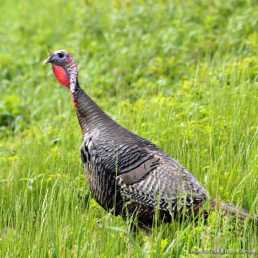Midwest’s Largest Game Bird
SHARE THIS POST
Overhunting and habitat loss at the turn of the 20th century pretty much eliminated turkeys from many Midwest woodlands. Reintroduced in the 1960s, turkeys have established themselves well.
Gobblers (male turkeys) have harems of up to 20 females. They can fly upwards of 60 mph. Turkeys have excellent hearing, and their eyesight is three times better than ours. If their sense of smell was as good, it’s almost certain that you would never take one with a bow or a shotgun.
Are you enjoying this post?
You can be among the first to get the latest info on where to go, what to use and how to use it!
Talking turkey
Using a turkey call is an effective way to lure in turkeys and a handy language to master when hunting. They have a limited but expressive “vocabulary” consisting of different calls: a yelp; a ‘kee-kee’ run, a relaxing-sounding purr and a soft, clucking call when they are seeking each other out at close range.
A real challenge
If you enjoy challenges, then try taking a turkey with a bow this spring. Use your ears to locate them, your eyes to tell you where they are going and your legs to get yourself between where they are and where they want to be. Wait for them to get there, draw when they’re not looking, and pick a spot. It’s tough hunting, but the challenge is worth it.
MWO
SHARE THIS POST
You may also like...
Nothing found.
Did you enjoy this post?
You can be among the first to get the latest info on where to go, what to use and how to use it!
MWO
We believe being outdoors is good. With more than 1,000 articles each year, MidWest Outdoors magazine is all about sharing outdoor experiences with you—where to go, what to use and how to use it… whether you’re close to home or on that trip of a lifetime.
